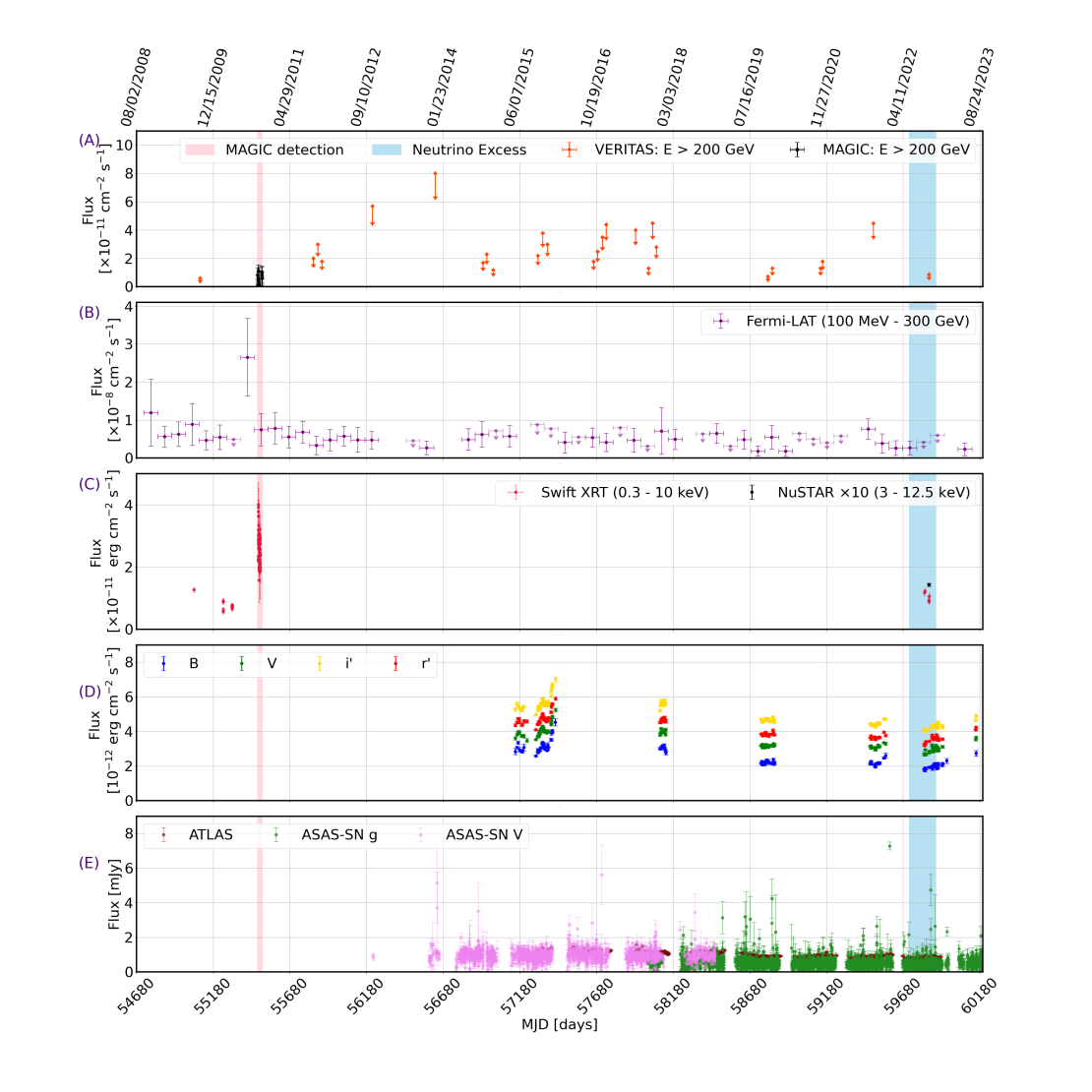Cosmic rays are extremely energetic charged particles that zoom through space and bombard the Earth’s atmosphere. Since cosmic rays get diverted by magnetic fields on their way to Earth, tracing their origins is more difficult. However, tiny, nearly massless particles called neutrinos, and photons at similar energies, can be used to trace cosmic rays back to their probable birthplaces.
Since 2016, the IceCube Neutrino Observatory at the South Pole has been issuing real-time alerts, sent to the public within minutes of the detection of likely astrophysical neutrinos. IceCube’s prompt observations are key in the emerging field of multimessenger astronomy, where the combined measurements across the electromagnetic spectrum are used to probe the nature of astrophysical phenomena, including the origin of cosmic rays.
Real-time alerts are followed up by different ground- and space-based telescopes that can point in the direction of the neutrino in the sky in order to identify a probable transient source of the neutrino. The Very Energetic Radiation Imaging Telescope Array System (VERITAS) ground-based gamma-ray telescope, located at the Fred Lawrence Whipple Observatory in Arizona, observes gamma rays in the GeV-TeV energy range. By monitoring for “neutrino flares” in known gamma-ray sources, researchers can look for an increased flux of photons when multiple neutrinos are detected from an astrophysical source.
In a joint study with the IceCube Collaboration, the VERITAS Collaboration reports on follow-up observations of an alert of multiple neutrino events coinciding with the location of a blazar, a supermassive black hole with a powerful jet of particles aimed at the Earth. The multiwavelength and VERITAS observations on blazar B3 2247+381 found no evidence for a correlation between the neutrino flare and the blazar. This study was accepted to The Astrophysical Journal.

“For the study, we looked at different wavelengths, from the optical to the very high-energy gamma rays,” says Atreya Acharyya, a postdoctoral researcher at the University of Southern Denmark and colead on the study. “Each band offers valuable insight and potential constraints on the processes responsible for neutrino and gamma-ray production and the activity taking place in the jets. When put together, they allow us to explore the presence of potential connections between the jets and neutrinos.”



VERITAS was used to observe very high-energy gamma rays, with energies comparable to those of particles accelerated in the world’s highest energy particle accelerator. At the same time, the Nuclear Spectroscopic Telescope Array (NuSTAR) was triggered to observe energetic X-rays from the blazar, upon receiving the neutrino alert from IceCube.
“We then combined these observations with other wavelengths to get a full picture of the light coming from the blazar,” says Samantha Wong, a physics PhD student at McGill University and study colead. “Then, we can see if it seems possible that both neutrinos and photons are coming from the blazar, or if it’s just a coincidence that we see neutrinos coming from the blazar location.”
As part of a NASA grant, Barnard College, Columbia University professor and VERITAS collaborator Reshmi Mukherjee started a project that seeks to identify sources that produce IceCube neutrinos using a multimessenger approach, triggering NuSTAR for target-of-opportunity observations for any interesting high-energy IceCube neutrino alerts that may be associated with an astrophysical gamma-ray source such as a blazar.
In 2021, VERITAS received an alert via the General Coordinates Network about an IceCube track-like event with an energy of about 170 TeV, prompting the trigger for the NuSTAR observation of the gamma-ray blazar B3 2247+381.

“The NuSTAR X-ray observations are key to understanding the electromagnetic spectrum and provide some of the strongest constraints on the luminosity of ultra-high-energy gamma rays and neutrinos,” says Elizabeth Spira-Savett, an undergraduate student at Barnard College, Columbia University who analyzed the NuSTAR data as part of her senior research project and Summer Research Institute internship in 2023. “Working with the VERITAS Collaboration members on this exciting project strengthened my motivation to work towards a career in astrophysics, and I am hoping to pursue a PhD in physics after I graduate in the spring.”
“We found the source at a low-photon-flux state when the neutrinos were detected. This suggests that either the neutrinos are from background fluctuation rather than coming directly from this source, or there is no association between neutrinos and photons in this source—similar to our Sun, where we detect neutrinos from the core but only observe photons from the photosphere,” says Qi Feng, assistant professor at the University of Utah and colead on the study.
The VERITAS Collaboration will continue exploring IceCube neutrino alerts across different energy bands in photons as well as different types of sources that might be associated with neutrinos.
“Since we didn’t find a gamma-ray flare connected to the IceCube neutrino alert, we still don’t have a good idea of what sort of connection to expect between these two messengers,” says Wong. “Studying more of these alerts and any potential neutrino sources that IceCube identifies can help us figure out which theories about neutrino, gamma-ray, and cosmic-ray production are plausible.”
Future studies will be further enhanced by IceCube-Gen2, the future high-energy extension of IceCube, and the Cherenkov Telescope Array Observatory, which, upon completion, will be the most powerful ground-based observatory for high-energy gamma-ray astronomy.
“Sharing data publicly with the scientific community at large or privately with partner instruments such as VERITAS is a cornerstone of IceCube’s science operation,” says IceCube spokesperson Ignacio Taboada. “These activities enable many multimessenger astrophysics studies, such as the one presented here”.
+ info “VERITAS and multiwavelength observations of the Blazar B3 2247+381 in response to an IceCube neutrino alert,” IceCube Collaboration: R. Abbasi et al. Accepted to The Astrophysical Journal. arxiv.org/abs/2502.03853